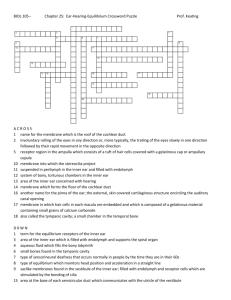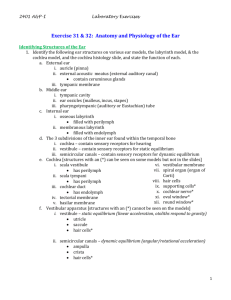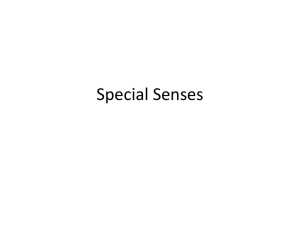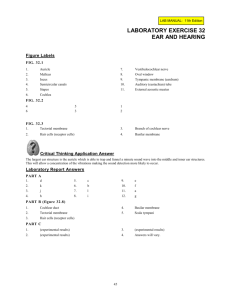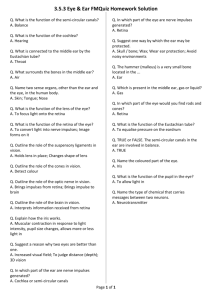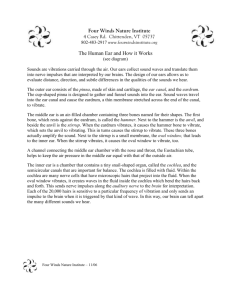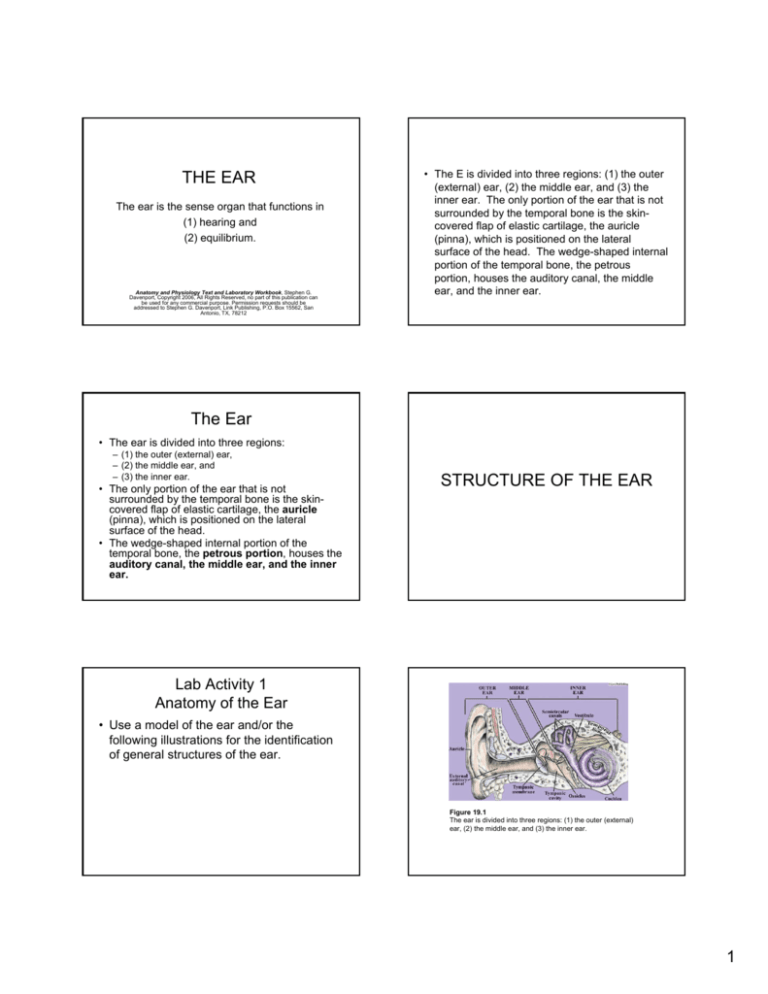
THE EAR
The ear is the sense organ that functions in
(1) hearing and
(2) equilibrium.
Anatomy and Physiology Text and Laboratory Workbook, Stephen G.
Davenport, Copyright 2006, All Rights Reserved, no part of this publication can
be used for any commercial purpose. Permission requests should be
addressed to Stephen G. Davenport, Link Publishing, P.O. Box 15562, San
Antonio, TX, 78212
• The E is divided into three regions: (1) the outer
(external) ear, (2) the middle ear, and (3) the
inner ear. The only portion of the ear that is not
surrounded by the temporal bone is the skincovered flap of elastic cartilage, the auricle
(pinna), which is positioned on the lateral
surface of the head. The wedge-shaped internal
portion of the temporal bone, the petrous
portion, houses the auditory canal, the middle
ear, and the inner ear.
The Ear
• The ear is divided into three regions:
– (1) the outer (external) ear,
– (2) the middle ear, and
– (3) the inner ear.
• The only portion of the ear that is not
surrounded by the temporal bone is the skincovered flap of elastic cartilage, the auricle
(pinna), which is positioned on the lateral
surface of the head.
• The wedge-shaped internal portion of the
temporal bone, the petrous portion, houses the
auditory canal, the middle ear, and the inner
ear.
STRUCTURE OF THE EAR
Lab Activity 1
Anatomy of the Ear
• Use a model of the ear and/or the
following illustrations for the identification
of general structures of the ear.
Figure 19.1
The ear is divided into three regions: (1) the outer (external)
ear, (2) the middle ear, and (3) the inner ear.
1
OUTER EAR
Figure 19.2
The general structure of the ear.
The outer ear consists of the
(1) auricle (pinna) and the
(2) external auditory canal.
Outer ear
• Auricle (pinna)
– The auricle is the skin-covered flap of elastic cartilage located on
the lateral surface of the head. The auricle traps and directs
sound waves into the external auditory canal.
MIDDLE EAR
• External auditory canal
– The external auditory canal is the canal that carries sound waves
from the auricle to the tympanic membrane.
• Tympanic membrane (eardrum)
– The tympanic membrane is a fibrous membrane that forms the
boundary between the outer and the middle ear. The tympanic
membrane transfers sound waves to the first ossicle, the malleus
of the middle ear.
The middle ear consists of the
tympanic cavity, an air-filled cavity that
houses three bones, the ossicles.
Middle Ear
Middle Ear
• Ossicles
• The middle ear consists of the tympanic
cavity, an air-filled cavity that houses three
bones, the ossicles.
– The pharyngotympanic tube (Eustachian,
or auditory, tube) connects the middle ear to
the nasopharynx for the equalization of air
pressure between the tympanic cavity and the
external environment.
The ossicles are the bones that cross the middle ear.
The names of the ossicles from the tympanic membrane to the oval
window are
– (1) the malleus,
– (2) the incus, and
– (3) the stapes.
• The malleus conducts sound vibrations from the
tympanic membrane to the incus. The incus conducts
to the stapes, which conducts to the oval window of the
vestibule.
• The oval window is a membranous window of the
vestibule that allows the passage of vibrations into the
fluids of the cochlea.
• In the process of conduction across the middle ear
sound vibrations are amplified by the ossicles about
thirty times.
2
Lab Activity 2
The Ossicles
• Observe natural bone human ossicles
and/or the following photograph.
– Because of their small size and delicate
structure, natural bone ossicles are usually in
a protected display case.
Figure 19.3
The ossicles conduct sound vibrations across the middle
ear. In the process of conduction vibrations are amplified
by the ossicles about thirty times.
INNER EAR
Figure 19.4
Natural bone human ossicles. The stapes is about the width of a
grain of rice. The ossicles transmit and amplify sound vibrations
from the tympanic membrane to the oval window of the cochlea.
The inner ear consists of
(1) the cochlea,
(2) the vestibule, and
(3) the semicircular canals.
Inner Ear
•
The inner ear consists of
– (1) the cochlea,
– (2) the vestibule, and
– (3) the semicircular canals.
•
•
•
As with the auditory canal and the middle ear, the inner ear is also
surrounded by the petrous portion of the temporal bone.
The inner ear consists of a series of complex cavities that
interconnect forming a maze-like structure, a labyrinth. Bone
surrounds the structures of the inner ear and forms a cavity, called
the osseous labyrinth. The osseous labyrinth contains a fluid
called perilymph.
The structures of the inner ear, a series of canals and receptors, are
called the membranous labyrinth. The membranous labyrinth
extends through the bony labyrinth, and thus is surrounded by
perilymph. Internally, the membranous labyrinth contains a fluid
called endolymph.
Figure 19.5
A portion of the left ear is exposed by dissection of the human skull
with a bone saw. The bony chambers of the inner ear, which include
the cochlea and the semicircular canals, are shown. These chambers
are called the bony labyrinth and house the membranous labyrinth, a
series of canals and receptors that function as the sensory receptors of
the inner ear.
3
Figure 19.6
General structure of the inner ear. The inner ear consists
of three major regions, the semicircular canals, the
vestibule, and the cochlea.
Figure 19.7
General structure of the inner ear. The illustrations show the
structure of the cochlea both coiled and uncoiled.
Cochlea
The cochlea is the coiled, “snail-shaped” portion of the
inner ear. It consists of about 2 ½ turns of a cavity
(osseous labyrinth) that encloses a membranous canal
of three fluid-filled chambers, the
– (1) scala vestibuli,
– (2) cochlear duct (scala media), and
– (3) scala tympani.
• Scala Vestibuli
– The scala vestibuli begins at the base of the cochlea at the oval
window, the membranous window that junctions with the stapes.
The scala vestibuli continues to the tip of the cochlea (cochlear
apex). At the cochlear apex the scala vestibuli merges with the
scala tympani at a region called the helicotrema.
Cochlea
• Scala tympani
– The scala tympani continues back toward the base of the
cochlea where it ends at the round window. The round window
is located in the wall of the middle ear. Both the scala vestibuli
and the scala tympani contain a fluid called perilymph.
• Cochlear duct (or scala media)
– Located between the scala vestibuli and the scala tympani is the
cochlear duct (or scala media). The cochlear duct contains the
receptor, the organ of Corti, where sound vibrations are
converted into electrical stimuli. The cochlear duct is continuous
with the membranous cavities and canals of the vestibule and
the semicircular canals. The cochlear duct and its associated
cavities and canals contain the fluid called endolymph.
Figure 19.8
The cochlea is the coiled, “snail-shaped” portion of the inner ear. It
consists of about 2 ½ turns of a cavity (osseous labyrinth) that
encloses a membranous canal of three fluid-filled chambers, the (1)
scala vestibuli, (2) cochlear duct (scala media), and (3) scala
tympani.
Vestibule
• The vestibule is the portion of the inner ear
located between the cochlea and the
semicircular canals.
• The vestibule contains two regions,
– (1) the saccule and
– (2) the utricle, each containing receptors called
maculae (spot-like areas), the macula sacculi and
the macula utriculi, respectively.
– The maculae respond to gravity and linear motion
and function in equilibrium and maintenance of
body position.
4
Semicircular Canals
• Each of the three semicircular canals,
– (1) the anterior,
– (2) the posterior, and
– (3) the lateral, projects from the vestibule in the
direction descriptive of its name.
– Each semicircular canal contains a fluid-filled
membranous duct, the semicircular duct, that has
an enlarged area called an ampulla.
– Each ampulla contains a receptor, the crista
ampullaris, that responds to rotational motion and
maintains equilibrium.
Figure 19.9
The vestibule is the portion of the inner ear located
between the cochlea and the semicircular canals.
Semicircular Canals
•
The semicircular canals are position to respond to movement in the
three planes of space, the
– (1) sagittal plane,
– (2) frontal plane, and the
– (3) horizontal plane.
•
•
Figure 19.10
The three semicircular canals, (1) the anterior, (2) the
posterior, and (3) the lateral, project from the vestibule in
the direction descriptive of its name. The semicircular
canals function in reception of rotational movements.
Two of the semicircular canals, the anterior and posterior, project
vertically and respond to rotational motion in the two vertical
planes, the sagittal plane (front-back rotation) and the frontal
plane (side-to-side rotation).
Anterior and Posterior Semicircular Canals
– The anterior semicircular canal responds to front/back rotational
motion (sagittal plane) such as in swaying the head in indicating “yes,”
and the posterior semicircular canal responds to side/side rotational
motion (frontal plane) such as swaying the head side-to-side.
•
Lateral Semicircular Canal
– The lateral semicircular canal responds to rotational motion in the
horizontal plane such as the rotating the head in indicating “no.”
Figure 19.11
The semicircular canals follow three planes and respond to
rotational movements to maintain equilibrium.
5
Lab Activity 3
Cochlea
• Observe a slide preparation labeled “Cochlea”
and/or the following illustrations and
photographs. Preparations of the “cochlea” are
obtained by sectioning specimens of the inner
ear.
– Thus, in addition to the cochlea, the slide preparation
may show other structures of the inner ear such as
the semicircular canals (with their ducts and
receptors such as the crista ampullaris) and a region
of the vestibule (with its receptor, the macula).
– Usually, the inner ear specimen is section so that the
cochlea shows its central axis with the cochlea’s
individual turns.
Figure 19.12
The cochlea is sectioned along its central axis to produce a
view showing the cochlea’s individual turns.
Lab Activity 3
Cochlea
• Each section of a turn of the cochlea contains
sections of three chambers. The three
chambers are
– (1) the scala vestibuli,
– (2) the cochlear duct (scala media), and
– (3) the scala tympani.
• The bony cochlea spirals around a central
region called the modiolus.
Figure 19.13
A photograph of a sectioned inner ear. In addition to the
cochlea, the slide preparation may show other structures of
the inner ear such as the semicircular canals and vestibule.
This photograph shows the semicircular canals housing the
semicircular ducts and a receptor, the crista ampullaris.
– The modiolus houses the spiral ganglion, a region
that contains the cell bodies of the cochlea’s sensory
neurons. Fibers from the spiral ganglion exit to form
the cochlear nerve.
Lab Activity 3
Cochlea
• Observe a single turn of the cochlea.
Frequently, structural damage occurs
when the specimen is sectioned, so
several turns may have to be examined
before all of the structures are identified.
Figure 19.14
The three chambers are (1) the scala vestibuli, (2) the cochlear
duct (scala media), and (3) the scala tympani. The cochlear duct
contains the organ of hearing, the organ of Corti.
6
Lab Activity 3
Structures of Cochlea
• Scala vestibuli
– The scala vestibuli is the chamber that originates at the oval
window. The oval window transfers sound vibrations from the
stapes into the fluid of the scala vestibuli, the perilymph. A thin
membrane, the vestibular membrane, forms the floor of the scala
vestibuli.
• Cochlear duct (scala media)
– The cochlear duct is the middle chamber located between the
scala vestibuli and the scala tympani. The vestibular membrane
forms its roof. The floor of the cochlear duct is formed by the
basilar membrane on which sits the organ of hearing, the organ
of Corti. Sound vibrations pass from the scala vestibuli into the
cochlear duct.
Figure 19.15
A photograph of a cross section of a turn of the cochlea as seen with
low power magnification. Each section of a turn of the cochlea contains
sections of three chambers. The three chambers are (1) the scala
vestibuli, (2) the cochlear duct (scala media), and (3) the scala tympani.
Lab Activity 3
Structures of Cochlea
• Scala tympani
– The scala tympani is the chamber inferior to the basilar
membrane. It terminates at the round window, which is located
inferior and posterior to the oval window. Sound vibrations that
pass into the scala tympani are absorbed by the round window.
• Organ of Corti
– The organ of Corti, or the organ of hearing, consists of
• (1) supporting cells and
• (2) receptor cells (hair cells).
• The hair cells generate electrical potentials when vibrations of the
basilar membrane move their “hairs” (stereocilia) against the
overhanging tectorial membrane.
• Basilar membrane
– The basilar membrane is a fibrous membrane that forms the floor
of the cochlear duct (scala media). The organ of Corti sits upon
on its surface. Sound (pressure) vibrations in the cochlear duct
set the basilar membrane and its associated organ of Corti into
motion.
Lab Activity 3
Structures of Cochlea
• Observe the details of the organ of Corti,
the
– (1) supporting cells and
– (2) receptor cells (hair cells) with high
magnification. Usually, the minute “hairs”
(stereocilia) of the hair cells cannot be
observed.
Lab Activity 3
Structures of Cochlea
• Tectorial membrane
– The tectorial membrane is a gelatinous membrane
that overhangs and contacts the hair cells of the
organ of Corti. During specimen preparation, the
tectorial membrane may be moved away from its
overhanging position.
• Spiral ganglion
Figure 19.16
The organ of hearing, the organ of Corti, consists of (1)
supporting cells and (2) receptor cells (hair cells). The hair
cells generate nerve impulses when vibrations of the basilar
membrane move their “hairs” (stereocilia) against the
overhanging tectorial membrane.
– The spiral ganglion is located in the modiolus and
follows the turns of the bony tube. The spiral
ganglion consists of the cell bodies of the sensory
neurons that form the cochlear nerve. The cochlear
nerve merges with the vestibular nerve to form the
vestibulocochlear nerve (cranial nerve VIII).
7
Sound
MECHANISM OF HEARING
• Sound is a form of energy that consists of vibrations
that are transmitted through elastic, solid, liquid, or gas
mediums with a frequency range of 20 - 20,000 hertz,
the frequency range that is capable of detection by the
human ear.
• A sound wave is produced as a vibrating structure,
such as the vocal cords, pushes against (compresses)
air molecules then rebounds to produce an area of less
compression.
• Thus, air molecules leave a vibrating surface as sound
waves, each sound wave consisting of an area of high
compression (high pressure) followed by an area of
low compression (low pressure).
Sound
Sound
• Frequency
• Wavelength
– The distance from a wave peak to the next
wave peak is the wavelength. In a given
period of time, an increased number of
waves can be presented by decreasing their
wavelength, or in the same given period of
time, a decreased number of waves can be
presented by increasing their wavelength.
Figure 19.17
Air molecules leave a vibrating surface as sound waves,
each sound wave consisting of an area of high
compression (high pressure) followed by an area of low
compression (low pressure).
– Frequency is the number of vibrations (or waves) in a
given unit of time.
– Hertz is a unit of frequency measurement, where one
hertz is equivalent to one cycle (wave) per second.
The greater the number of cycles (waves) per second
the shorter the wavelength and the higher the
frequency (higher hertz). Thus, the frequency of 20
hertz exhibits twenty cycles (waves) per second and
is the lowest frequency that a human can hear. The
frequency of 20,000 hertz exhibits twenty thousand
cycles (waves) per second, and is the highest
frequency that a human can hear.
– Pitch is the quality of the sound that is dependent on
the frequency. The higher the pitch the higher the
frequency, the lower the pitch the lower the
frequency.
Figure 19.18
Frequency is the number of vibrations (high compressions - low
compressions, or waves) in a given unit of time.
8
Sound
• Amplitude
– Amplitude is the intensity of sound, or the
quantity of the energy of the wave. In hearing
amplitude is interpreted as loudness.
– The greater the amplitude of the sound
waves, the louder the sound. The decibel is
a unit (logarithmic) used to express the
intensity of sound.
Figure 19.19
Amplitude is the intensity of sound, or the quantity of
the energy of the wave. In hearing amplitude is
interpreted as loudness.
Sound Conduction to the Cochlea
PATHWAYS OF SOUND
CONDUCTION
Sound Conduction to the Cochlea
• As the pressure waves (energy of the sound
waves) pass along the perilymph, they set into
motion regions of the basilar membrane.
• The regions of the basilar membrane that are
set into motion are determined by the basilar
membrane’s structure.
– The area of the basilar membrane that is closest to
the oval window (base of cochlea) is structured to
respond and move when stimulated by pressure
waves of high frequency.
– Moving toward the apex of the cochlea (away from
the oval window) the basilar membrane is set into
motion by increasingly lower frequencies.
• Sound waves passing along the auditory canal strike the
tympanic membrane and set it into motion.
• The vibrations of the tympanic membrane are transferred
to the first ossicle, the malleus. The ossicular chain
transfers and amplifies the sound vibrations by way of
the last ossicle, the stapes, to the oval window.
• The oval window transfers the sound vibrations as
pressure waves to the fluid, the perilymph, of the
cochlear chamber called the scala vestibuli. The
pressure waves pass along the perilymph of the scala
vestibuli and continue into the perilymph of the scala
tympani. At the terminus of the scala tympani the
pressure waves strike the round window, which
absorbs their energy.
Sound Conduction to the Cochlea
• Frequency and Amplitude
– Thus, frequency is determined by the
location of the basilar membrane that is set
into motion. The amplitude (intensity) of the
pressure waves determines how much the
basilar membrane is moved. Loud sounds
produce large (high amplitude) waves that
result in greater movement of the basilar
membrane than softer sounds produce.
9
Sound Conduction to the Cochlea
• Depolarization and Conduction
– When the basilar membrane moves, it moves the associated
hair cells of the organ of Corti. The hair cells are moved against
the tectorial membrane resulting in the bending of their “hairs”
(extensions of the plasma membrane called stereocilia). The
hair cells are depolarized by the movement of their stereocilia.
Depolarization of the hair cells leads first to the depolarization
of bipolar cells in the spiral ganglion, then to the
depolarization of the cochlear fibers.
– The cochlear fibers produce the action potentials transmitted by
the cochlear nerve.
– Increased movement of the basilar membrane (due to increased
amplitude of the pressure waves) increases the number of hair
cells that are depolarized. Increased stimulation by increasing
the number of stimulated hair cells results in neural information
that is interpreted as the loudness of the sound.
Figure 19.20
Pathway for the conduction of sound energy from the
auditory meatus to transduction at the organ of Corti.
Neural Conduction to the Brain
Neural Conduction to the
Brain
• The cochlear nerve leaves the cochlea and joins the
vestibular nerve as the vestibulocochlear nerve
(cranial nerve VIII). As the vestibulocochlear nerve
enters the brainstem cochlear fibers branch into the
cochlear nucleus the medulla.
• Most fibers crossover to the opposite side of the brain
and enter the midbrain. Some fibers target the midbrain
and their sensory information in used in auditory
reflexes.
• Fibers leave the midbrain and enter the thalamus, the
sensory relay center of the brain. The thalamus functions
to distribute the sensory information to specific areas of
the auditory cortex of the temporal lobe for
interpretation.
HEARING TESTS
Figure 19.21
Simplified pathways showing the route of cochlear fibers.
10
Hearing Tests
Deafness is the term used to describe any loss of
hearing. It is classified as either
– (1) conduction deafness or
– (2) sensorineural deafness.
Weber’s and Rinne’s Tests
•
Weber’s and Rinne’s tests are used to differentiate between
conduction and sensorineural deafness.
Weber’s Test
– Weber’s test is used to screen for conduction or sensorineural
deafness. A vibrating tuning fork in placed centrally on the forehead or
the head. Sound should be heard equally well in both ears (no
lateralization) if there is no conduction or sensorineural deafness.
• Conduction deafness
– Conduction deafness results from any loss of hearing due to the
inability of sound to be conducted to the sensory apparatus
(organ of Corti) of the inner ear. Causes include occlusion of the
external auditory canal, damage to the tympanic membrane,
inflammation of the middle ear, and immobility of the ossicles
(otosclerosis).
• Sensorineural deafness
– Sensorineural deafness results from any loss of hearing due to
damage to the sensory apparatus (organ of Corti) or damage to
neural transmission (vestibulocochlear nerve, VIII).
Lab Activity 4
Weber’s Test
•
Conductive hearing loss
– If there is a conductive hearing loss, lateralization (better hearing)
occurs in the ear with conductive hearing loss (unilateral conductive
hearing loss). The affected ear is receiving sound mostly by bone
conduction and extraneous room noise is blocked. Thus, the affected
ear hears this sound louder.
•
Sensorineural hearing loss
– If there is a sensorineural hearing loss, lateralization occurs to the
better ear.
Weber’s and Rinne’s Tests
• Rinne’s Test
• Procedure
– Place a vibrating tuning fork (512 Hz) onto the
center of the forehead (or head).
– Ask the subject if the sound is heard better in
(1) the left ear, (2) right ear, or (3) equally well
in both ears.
– Record the subject’s answer in the worksheet.
– Hearing by conduction of sound by air is about two
times better than hearing by bone conduction.
– If a vibrating tuning fork is placed on the mastoid
process, the subject hears the sound mostly by bone
conduction. If the still vibrating tuning fork is
immediately moved to the position in front of the
external auditory canal, the subject should hear the
sound louder.
– If there is conductive hearing loss, bone conduction
is heard louder than air conduction.
– If there is sensorineural hearing loss, both air
conduction and bone conduction are reduced with air
conduction being better than bone conduction.
Lab Activity 4
Rinne’s Test
• Procedure
– Place a vibrating tuning fork (512 Hz) onto the
mastoid process of the right ear.
– Ask the subject to tell you immediately when the
sound can no longer be heard. Then, quickly position
the tuning fork in front of the external auditory canal.
– Ask the subject if the sound can still be heard.
– Repeat the test for the left ear.
– Record the subject’s answer in the worksheet.
EQUILIBRIUM
Equilibrium is a function of sensory structures
of the inner ear that register the orientation of
the head. The regions of the inner ear that
function in equilibrium are the vestibule and
the semicircular canals.
11
Vestibule
• The vestibule is the portion of the inner ear located
between the cochlea and the semicircular canals.
• The vestibule contains two regions,
– (1) the saccule and
– (2) the utricle,
• The saccule and utricle house receptors called maculae
(spot-like areas), the macula sacculi and the macula
utriculi, respectively.
• The receptors of the maculae respond to gravity and
linear motion and function in equilibrium and
maintenance of body position by detecting the
orientation of the head.
Figure 19.22
The vestibule is the portion of the inner ear located
between the cochlea and the semicircular canals. The
vestibule contains two regions, (1) the saccule and (2)
the utricle, each containing receptors called maculae.
Maculae
• The maculae of the vestibule (the saccule and utricle)
consist of areas of hair cells covered with a gelatinous
material containing small crystals of calcium carbonate,
the otoliths.
• Gravity and linear movements influence the position of
the gelatinous material and otoliths in respect to the hair
cells. Movement of the otoliths and the gelatinous
material over the “hairs” (stereocilia) of the hair cells,
results in changes in the polarity of the hair cells.
• Thus, depending upon the polarity (hyperpolarization or
depolarization) of the hair cells, they can increase or
decrease production of action potentials (nerve
impulses) of the vestibular nerve fibers.
Figure 19.23
The maculae of the vestibule
(the saccule and utricle) consist
of areas of hair cells covered
with a gelatinous material.
Embedded in the gelatinous
material are small crystals of
calcium carbonate, the otoliths.
A high power photograph of a
macula is shown with its
associated otoliths and
gelatinous material.
Semicircular canals
• Each of the three semicircular canals,
Figure 19.24
The otoliths and the associated gelatinous material move against the
“hairs” (stereocilia) of the hair cells in response to gravity and straight
line linear movements. Movement of the stereocilia results in electrical
changes in the hair cells providing the stimulus for excitation or
inhibition of the vestibular fibers.
– (1) the anterior,
– (2) the posterior, and
– (3) the lateral, projects from the vestibule in the
direction descriptive of its name.
– Each semicircular canal contains a fluid-filled
membranous duct, the semicircular duct, that has an
enlarged area called an ampulla.
– Each ampulla contains a receptor, the crista
ampullaris, that responds to rotational motion and
maintains equilibrium.
12
Semicircular Canals
• Two of the semicircular canals, the anterior and
posterior, project vertically and respond to
rotational motion in the two vertical planes, frontback (sagittal plane) and side-to-side (frontal
plane).
– The anterior semicircular canal responds to front/back
(sagittal plane) rotational motion such as in swaying
the head in indicating “yes,” and the posterior
semicircular canal responds to side/side (frontal
plane) rotational motion such as swaying the head
side-to-side.
Figure 19.25
The three semicircular canals, (1) the anterior, (2) the
posterior, and (3) the lateral, project from the vestibule in
the direction descriptive of its name. The semicircular
canals function in reception of rotational movements.
• The lateral semicircular canal responds to
rotational motion in the horizontal plane such as
the rotating the head in indicating “no.”
Lab Activity 6
Crista ampullaris
• Observe a slide preparation labeled
“Crista ampullaris.” Each of the fluid-filled
semicircular canals has an enlarged area
called an ampulla. Each ampulla contains
a receptor, the crista ampullaris.
• The crista ampullaris consists of
– (1) hair cells (receptors) that are covered by a
gelatinous material called the
– (2) cupula.
Figure 19.26
The semicircular canals follow three planes and interpret
rotational movement for maintaining equilibrium.
Lab Activity 6
Crista ampullaris
•
Figure 19.27
Each semicircular canal contains a fluid-filled membranous duct, the
semicircular duct, that has an enlarged area called an ampulla.
Each ampulla contains a receptor, the crista ampullaris, that
responds to rotational motion.
A rotational movement of the head causes the fluid
(endolymph) in a semicircular duct to move against the
cupula of the crista ampullaris.
• The movement of the cupula stimulates the hair cells.
The hair cells produce electrical stimuli that result in
either depolarization or hyperpolarization of the
vestibular nerve fibers.
• Depolarization of the vestibular fibers results in nerve
impulses that leave the crista ampullaris by way of the
vestibular nerve.
• The vestibular nerve joins with the cochlear nerve to
form the vestibulocochlear nerve (VIII), which enters the
brainstem.
13
Figure 19.29
This photograph shows a cross section of a semicircular canal. Each
canal contains a semicircular duct that houses fluid called endolymph.
Rotation of the head results in movement of the endolymph against a
receptor called the crista ampullaris. The osseous labyrinth surrounds
the semicircular ducts and contains perilymph.
Figure 19.28
A photograph of a sectioned inner ear. This photograph shows
the semicircular canals housing the semicircular ducts and a
receptor, the crista ampullaris.
PATHWAY TO THE BRAIN
•
•
•
•
Figure 19.30
This photograph shows the crista ampullaris. The crista ampullaris is
located in an enlarged area of the semicircular canal, the ampulla.
Movement of endolymph against the cupula stimulates the hair cells.
The hair cells produce electrical stimuli that result in either depolarization
or hyperpolarization of the vestibular nerve fibers.
The vestibular nerve fibers join to form the vestibular nerve. The
vestibular nerve merges with the cochlear nerve to form the
vestibulocochlear nerve (VIII).
Each vestibulocochlear nerve enters the brain stem where vestibular
fibers from each nerve enter two vestibular nuclei.
Each of the two sets of vestibular nuclei functions to maintain
equilibrium and to control eye movements in the stabilization of the
visual image on the retina during head movement.
To obtain this function vestibular information is relayed to several
central nervous system areas. Among these areas, information is
relayed to the cerebellum for motor coordination, to the cerebral
cortex for conscious awareness, and to other brain stem nuclei (to
control eye and motor movements), and to motor tracts of the spinal
cord.
14

